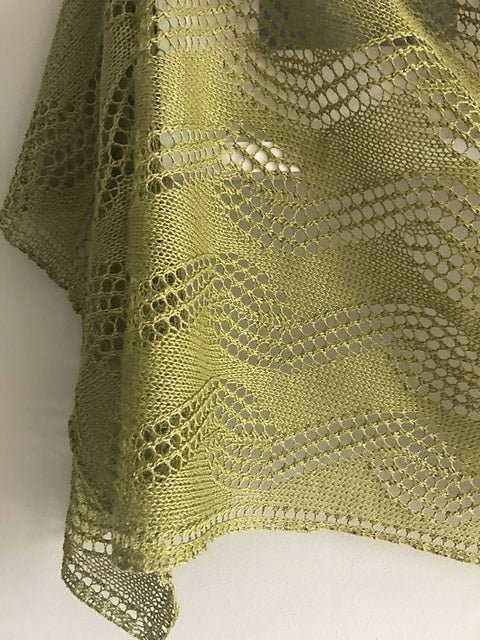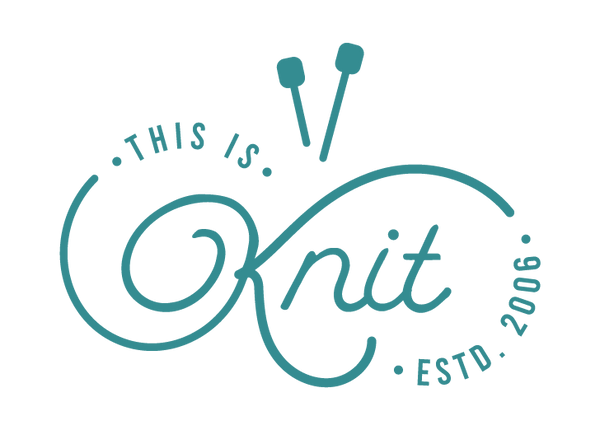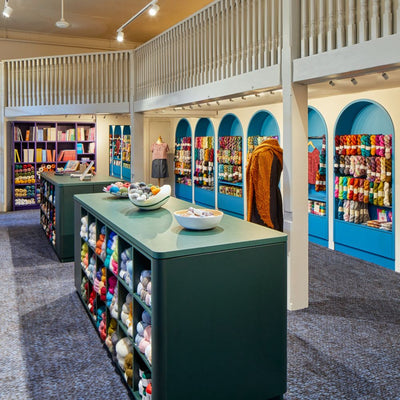Let's Talk Tension
July 01 2017 – thisisknit

"My tension is terrible." It's a phrase we hear in the shop a lot. Too much, actually, because so often it is based on a simple misunderstanding.
There are two main reasons people tend to feel this statement applies to them, and I'd like to tackle one of them today. Often people say this when they start a beautiful new project and then get disheartened when their work-in-progress doesn't look like the beautiful fabric photographed in the pattern. Let's take this shawl for example:
 This beautiful wrap was knit by Deirdre, a talented TIK customer, as a special gift for a bride-to-be. The stitches are crisp, the pattern is clear, and the fabric drapes elegantly. And her tension? So even! So perfectly smooth and neat. It's almost machine-like, right?
Well, erm... nope.
Let's take a look at two progress pics, shall we?
This beautiful wrap was knit by Deirdre, a talented TIK customer, as a special gift for a bride-to-be. The stitches are crisp, the pattern is clear, and the fabric drapes elegantly. And her tension? So even! So perfectly smooth and neat. It's almost machine-like, right?
Well, erm... nope.
Let's take a look at two progress pics, shall we?

 You can imagine a knitter, particularly one new to lace knitting, being terribly disheartened looking down at their needles. Having taken the leap in to a new technique, and perhaps struggled with charts or new stitch patterns, they might abandon the project in frustration because it simply does not look like the pattern picture.
So what's the missing link? Blocking. We've covered the process of blocking before, if you'd like a break-down of the how-tos. Essentially you let your project take a long, relaxing soak and then smooth, shape and pin it while it's still damp. Once dry, the fabric will retain the shape it was pinned to, and your stitches will have relaxed to a smooth and even finish. Here's the same piece of knitting, pinned to Deirdre's yoga mat:
You can imagine a knitter, particularly one new to lace knitting, being terribly disheartened looking down at their needles. Having taken the leap in to a new technique, and perhaps struggled with charts or new stitch patterns, they might abandon the project in frustration because it simply does not look like the pattern picture.
So what's the missing link? Blocking. We've covered the process of blocking before, if you'd like a break-down of the how-tos. Essentially you let your project take a long, relaxing soak and then smooth, shape and pin it while it's still damp. Once dry, the fabric will retain the shape it was pinned to, and your stitches will have relaxed to a smooth and even finish. Here's the same piece of knitting, pinned to Deirdre's yoga mat:
 It's a process that is easy to overlook, especially if you've never knit anything like this before. It's mentioned in all good patterns, but generally in one quick line at the end, without explanation as to the process or any emphasis on how essential it can be. In this project the elegant lace pattern is opened up and revealed, but you can also see the simple stockinette sections have benefited too: the fabric is smoother and the stitches have become more even.
Any project made from predominantly natural fibres will appear to have a neater tension after blocking, so it's worth doing even for a simple scarf or hat. (Check out our bonus tip for hats that are knit in the round.) Why not just try it on a small swatch, and see what you think of the results. Trust us: your tension isn't terrible.
Thank you so much for Deirdre for the images, and for allowing us to use her stunning shawl as "Exhibit A" in our fight against the concept of "terrible tension".
If you'd still like more evidence, then try this epic thread on Ravelry, with before-and-after blocking pictures from thousands of members!
Case closed...
PS: If you'd like to make your own version of this project, it was knit with one ball of Juniper Moon Findley, and the pattern is free on Ravelry.
It's a process that is easy to overlook, especially if you've never knit anything like this before. It's mentioned in all good patterns, but generally in one quick line at the end, without explanation as to the process or any emphasis on how essential it can be. In this project the elegant lace pattern is opened up and revealed, but you can also see the simple stockinette sections have benefited too: the fabric is smoother and the stitches have become more even.
Any project made from predominantly natural fibres will appear to have a neater tension after blocking, so it's worth doing even for a simple scarf or hat. (Check out our bonus tip for hats that are knit in the round.) Why not just try it on a small swatch, and see what you think of the results. Trust us: your tension isn't terrible.
Thank you so much for Deirdre for the images, and for allowing us to use her stunning shawl as "Exhibit A" in our fight against the concept of "terrible tension".
If you'd still like more evidence, then try this epic thread on Ravelry, with before-and-after blocking pictures from thousands of members!
Case closed...
PS: If you'd like to make your own version of this project, it was knit with one ball of Juniper Moon Findley, and the pattern is free on Ravelry.

 This beautiful wrap was knit by Deirdre, a talented TIK customer, as a special gift for a bride-to-be. The stitches are crisp, the pattern is clear, and the fabric drapes elegantly. And her tension? So even! So perfectly smooth and neat. It's almost machine-like, right?
Well, erm... nope.
Let's take a look at two progress pics, shall we?
This beautiful wrap was knit by Deirdre, a talented TIK customer, as a special gift for a bride-to-be. The stitches are crisp, the pattern is clear, and the fabric drapes elegantly. And her tension? So even! So perfectly smooth and neat. It's almost machine-like, right?
Well, erm... nope.
Let's take a look at two progress pics, shall we?

 You can imagine a knitter, particularly one new to lace knitting, being terribly disheartened looking down at their needles. Having taken the leap in to a new technique, and perhaps struggled with charts or new stitch patterns, they might abandon the project in frustration because it simply does not look like the pattern picture.
So what's the missing link? Blocking. We've covered the process of blocking before, if you'd like a break-down of the how-tos. Essentially you let your project take a long, relaxing soak and then smooth, shape and pin it while it's still damp. Once dry, the fabric will retain the shape it was pinned to, and your stitches will have relaxed to a smooth and even finish. Here's the same piece of knitting, pinned to Deirdre's yoga mat:
You can imagine a knitter, particularly one new to lace knitting, being terribly disheartened looking down at their needles. Having taken the leap in to a new technique, and perhaps struggled with charts or new stitch patterns, they might abandon the project in frustration because it simply does not look like the pattern picture.
So what's the missing link? Blocking. We've covered the process of blocking before, if you'd like a break-down of the how-tos. Essentially you let your project take a long, relaxing soak and then smooth, shape and pin it while it's still damp. Once dry, the fabric will retain the shape it was pinned to, and your stitches will have relaxed to a smooth and even finish. Here's the same piece of knitting, pinned to Deirdre's yoga mat:
 It's a process that is easy to overlook, especially if you've never knit anything like this before. It's mentioned in all good patterns, but generally in one quick line at the end, without explanation as to the process or any emphasis on how essential it can be. In this project the elegant lace pattern is opened up and revealed, but you can also see the simple stockinette sections have benefited too: the fabric is smoother and the stitches have become more even.
Any project made from predominantly natural fibres will appear to have a neater tension after blocking, so it's worth doing even for a simple scarf or hat. (Check out our bonus tip for hats that are knit in the round.) Why not just try it on a small swatch, and see what you think of the results. Trust us: your tension isn't terrible.
Thank you so much for Deirdre for the images, and for allowing us to use her stunning shawl as "Exhibit A" in our fight against the concept of "terrible tension".
If you'd still like more evidence, then try this epic thread on Ravelry, with before-and-after blocking pictures from thousands of members!
Case closed...
PS: If you'd like to make your own version of this project, it was knit with one ball of Juniper Moon Findley, and the pattern is free on Ravelry.
It's a process that is easy to overlook, especially if you've never knit anything like this before. It's mentioned in all good patterns, but generally in one quick line at the end, without explanation as to the process or any emphasis on how essential it can be. In this project the elegant lace pattern is opened up and revealed, but you can also see the simple stockinette sections have benefited too: the fabric is smoother and the stitches have become more even.
Any project made from predominantly natural fibres will appear to have a neater tension after blocking, so it's worth doing even for a simple scarf or hat. (Check out our bonus tip for hats that are knit in the round.) Why not just try it on a small swatch, and see what you think of the results. Trust us: your tension isn't terrible.
Thank you so much for Deirdre for the images, and for allowing us to use her stunning shawl as "Exhibit A" in our fight against the concept of "terrible tension".
If you'd still like more evidence, then try this epic thread on Ravelry, with before-and-after blocking pictures from thousands of members!
Case closed...
PS: If you'd like to make your own version of this project, it was knit with one ball of Juniper Moon Findley, and the pattern is free on Ravelry.



2 comments
Hi guys. Am delighted to see my shawl featured. Although I am a fast knitter, Deirdre, this was for a wedding gift so I put extra effort in to get it done on time! Its the perfect project for starting lace so would encourage you to give it a try. Deirdre
Great post and pics, and what a beautiful shaw. Even I feel encouraged to MAYBE try a little lace knitting. I wish I was that Deirdre, who can knit that fast!
Thanks.
Deirdre (gansai)